Pak Choi is grown for its tasty leaves which are superb when added to stir fries and salads.
The taste is similar to that of mild cabbage and spinach and is a popular addition to many oriental dishes.
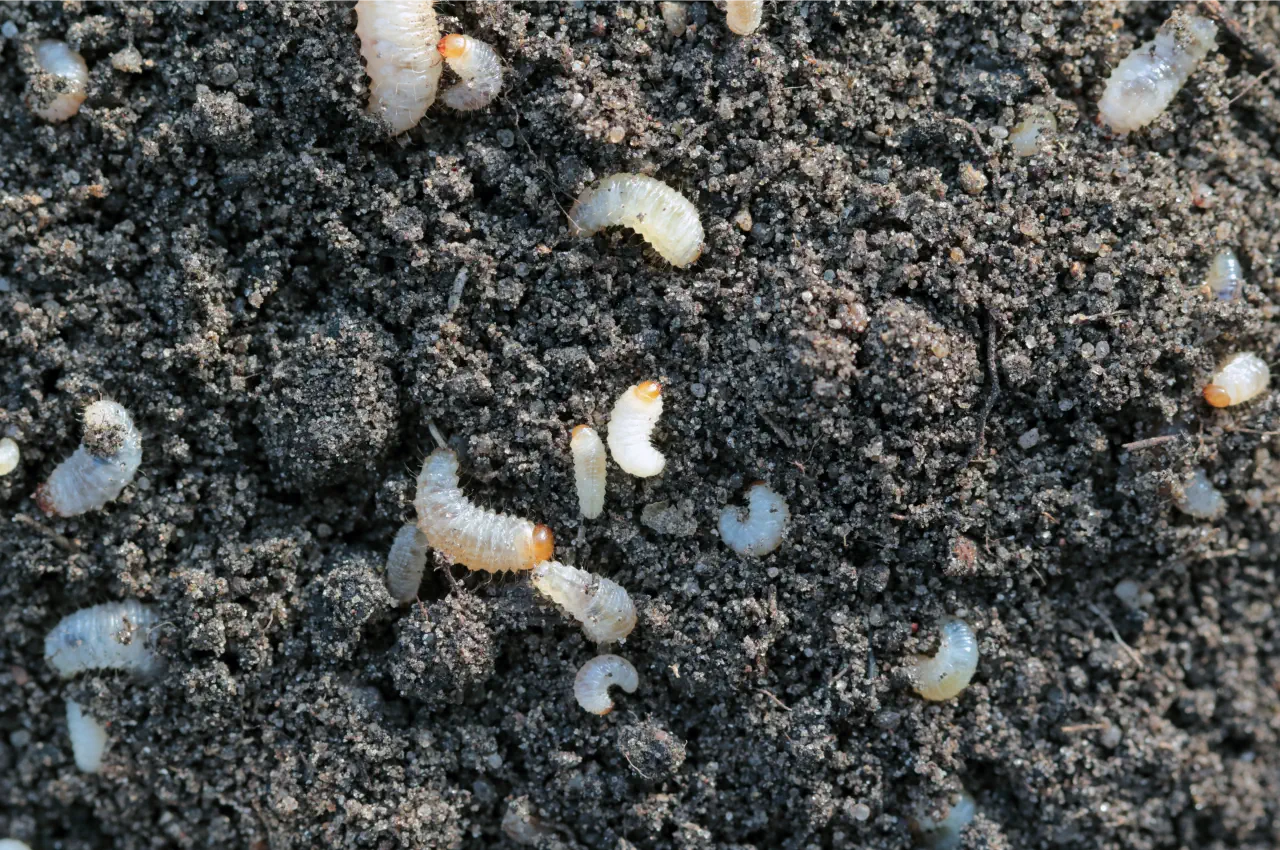
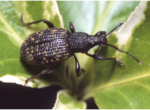 One of the most troublesome of all garden pests is the black vine weevil (Otiorhynchus sulcatus), which is simply known as the vine weevil. This common garden pest is native to Europe and North America, and will attack a large variety of garden plants.
One of the most troublesome of all garden pests is the black vine weevil (Otiorhynchus sulcatus), which is simply known as the vine weevil. This common garden pest is native to Europe and North America, and will attack a large variety of garden plants.
During the spring and summer months, adult beetles will attack and damage plant foliage, whilst the larvae are busy eating the plant’s roots underground. It can be very difficult to control the adults as they move freely from plant to plant during the night feeding and indiscriminately laying eggs in the soil. It’s therefore much easier to kill the larvae, which will then disrupt the life cycle.
Many broad leaved plants are particularly vulnerable to attack, including Bergenia, Camelia, Rhododendron and Hosta. However, Wisteria. Lilium and Phlox are also amongst the many favourites of the vine weevil. The female weevil is able to reproduce parthenogenetically, which means they can produce eggs without the need for male fertilisation. This capability may give the vine weevil a huge advantage in terms of reproduction but it also poses a major problem for gardeners, who may have many species of plants that are vulnerable to attack.
Host plant list by genus, which are most at risk:
|
|
The tell-tale signs
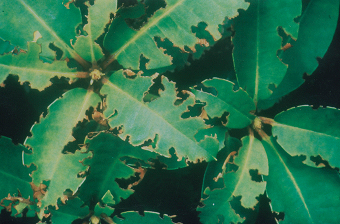
Leaf damage is visibly obvious as the adult weevils nibble at the edge of leaves, causing irregular-shaped notches in the leaf margins, during the summer months. However, root damage caused by the young larvae is not always immediately obvious. The plump, creamy white legless grubs have light brown heads and are up to 10mm long. They are likely to be found among the roots, where they feed voraciously.
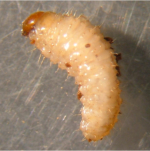
Affected plants will begin to wilt and eventually die, or they may appear to have stunted growth as a result of grubs damaging the roots, rendering them less efficient. Quite often, if the plant is lifted at this stage then the grubs can be seen in the soil and the damage to roots will be perfectly obvious.
Many types of plants including decorative pot plants and even fruit such as strawberries can become victim to the vine weevil and damage can occur anytime throughout the growing season. If left untreated the result can lead to certain plant death, so if you suspect your plants, especially those in pots and containers, are under attack then now is the time to take action.
Nematodes - The Safe and eco-friendly control
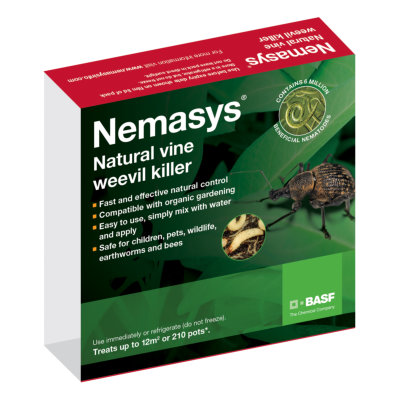
There are now several methods of treatment available including the traditional pesticides but there are also some eco-friendly options too. Pesticides can now be considered the last resort, as they can harm the environment and also be dangerous if used in areas frequented by children or pets. So a safe, natural biological control method is one solution worth considering. Nemasys Vine Weevil Killer is both safe and highly effective in the control of vine weevil grubs. The treatment consists of natural nematodes, a tiny parasitic worm that feeds on the vine weevil larvae.
Using a basic watering can, the nematodes can be applied to the soil between March and October. The nematodes (Steinernema kraussei), will actively seek out the vine weevil larvae and then feed on them, causing the grubs to die. The nematodes will quickly multiply ensuring an effective and very efficient control. One such control is Nemasys Vine Weevil Killer. This natural control method has been used successfully for years and is proven to be very effective in the control of wine weevil grubs. Once applied to pots and affected soil areas, the nematodes will remain active for up to 4 weeks.
Unique biological control method

If vine weevil is a serious problem in your garden or allotment then you can now fight back on two fronts. Nemasys Vine Weevil Killer is the perfect solution for controlling the vine weevil grubs in the soil but adults can be very evasive and much more difficult to eradicate. The answer could lie in the Nematop Adult Vine Weevil Trap. This unique control method is proving highly effective against adult vine weevils in and around the garden and the vegetable plot. This method involves using a clever trap to draw in the adult insects, which are then infected with nematodes, effectively dying a few days later.
The trap can be used from May to September, when growing season temperatures are typically between 12°C and 30°C. Used in conjunction with Nemasys Vine Weevil Killer, for grub control, gardeners now have a real edge over this particularly prevalent and damaging pest. For further information about Nemasys Vine Weevil Killer, visit this web page: www.simplyseed.co.uk/pest-control-nematodes/nemasys-vine-weevil-killer-nematodes.html
How the Nematop® Weevil-Stop trap Works...
Every Nematop® Weevil-Stop trap contains around 2.5 million tiny pathogenic nematodes for the effective control of adult black vine weevils. The adults are very difficult to find during daylight hours, preferring to hide away and using the cover of darkness to move from plant to plant. However, because the adults will seek out places to hide before sunrise, the wooden boarded traps make ideal hiding places. The small boards have recessed grooves, in which 20g of nematode laden gel is pressed. When adult vine weevils crawl under the boards in order to hide, they are immediately infected with the nematodes, who burrow into the insect, causing them to stop feeding. The result is they will then die, usually within 7 days.
This ingenious method is proving very popular amongst many gardeners, who are reporting very positive results. The wooden traps need to be placed gel side down on wet or damp soil, so ensure the soil area below plants is well watered if dry. Position the traps, gel side downwards, near affected plants allowing one board for each 10 square metres. Keep the areas damp during spells of dry weather. The nematodes will remain active for at least 6 weeks.
Further information....
● Remove the Nematop® Weevil-Stop trap from the packaging before use. If the gel appears to be loose within the grooves then spray lightly with water until the gel swells and fits tightly into the grooves once again.
● Wherever possible, try to lay the trap in the shade under the plant’s foliage rather than expose the device to direct and full sunlight where it can quickly dry out.
● One trap is generally sufficient for every 10m2 of ground area or up to 5 metres run of hedgerow.
● Vine Weevils are particularly fond of plants in pots or containers, where the roots are restricted. If containers are large enough then place one trap within the confines of the container’s soil surface.
● It is imperative that chemical pesticides are not used in conjunction with any biological control methods as nematodes will also be killed.
● After use, the Nematop® Weevil-Stop trap can be disposed of or burned just like any other waste wood material.
For further information about the Nematop® Weevil-Stop trap visit this web page: www.simplyseed.co.uk/pest-control-nematodes/nematop-adult-vine-weevil-nematode-trap.html

Alternative chemical treatment
If you really must use chemicals to control vine weevil then ensure the areas to be treated are situated well away from children and pets. Do not apply chemicals to fruit and vegetables and keep chemicals away from water courses, where fish and other water life might suffer as a result of pollution. The use of chemicals should be considered as a last resort. SimplySeed no longer sell the majority of chemical pesticides so for the effective chemical treatment of vine weevil visit this web page: https://www.amazon.co.uk/BugClear-Ultra-Weevil-Killer-Concentrate/dp/B00B5WKUN4
When to apply Treatments
Nemasys Vine Weevil Killer can be applied to pots or direct to the soil anytime from March to November. It is highly recommended to apply first in the spring and then again in the autumn to prevent the vine weevil grubs from overwintering in the soil or compost, ready to wreak havoc again in the following spring. Note that the nematodes are only active when soil temperatures are above 5°C. For the most effective control, simply add the nematodes to a watering can and apply directly to the open soil or directly to pots, tubs and containers.
The Nematop® Weevil-Stop trap can be used at the same time as Nemasys Vine Weevil Killer for a two pronged assault on the pests, which should prove to be twice as effective. However, the nematodes within the special gel need a higher temperature before they become active. It is therefore recommended the soil temperature be at least 12°C, and so May would be the ideal time to position the wooden traps.
If spraying is the preferred option, and as long as it is safe to do so, then apply Bug Clear Ultra Vine Weevil Killer Concentrate from mid-June to August.
Summary
Although vine weevil is one of the most troublesome of all garden pests the gardener now has some very effective methods of control options. In the first instance, look for signs of damage to leaves, which might indicate the presence of vine weevil. Plants that do not appear to be growing as well as they should, are sure signs that the vine weevil grubs may be active below ground.
Applying Nemasys Vine Weevil Killer in March, or early spring, when temperatures are at least 5°C will stop the grubs from becoming adults thus breaking the life cycle. However, the adults will still be wreaking havoc during the nights as they fly from plant to plant laying their eggs. To ensure adults are also eliminated, place Nematop® Weevil-Stop traps from May onwards.
If all else fails, and providing it is safe to do so, apply a chemical spray (Bug Clear Ultra Vine Weevil Killer Concentrate) during mid-June and again in August.
One of the most troublesome of all garden pests is the vine weevil. During the spring and summer months, adult beetles attack and damage plant foliage, whilst the larvae are busy eating the plant’s roots underground. It can be very difficult to control the adults as they move freely from plant to plant during the night feeding and laying eggs in the soil. It’s therefore much easier to kill the larvae and disrupt the life cycle.
Ensure your plants are fully protected - Order Nemasys Vine Weevil Killer today!
Did you find this post Useful? So will others, please like it on Facebook, or share on Twitter.
Have you any other top tips you think are worth a mention? Please leave a comment below and let us know....
All blog content on this page is copyright of SimplySeed and is not to be reproduced without prior written permission. ©
SimplySeed no longer sell the majority of chemical pesticides ourselves, if a reference to these products is required, we will refer to the appropriate product on Amazon - SimplySeed.co.uk is a participant in the Amazon Services LLC Associates Program, an affiliate advertising program designed to provide a means for sites to earn advertising fees by advertising and linking to Amazon.co.uk